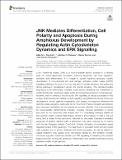Files in this item
JNK mediates differentiation, cell polarity and apoptosis during amphioxus development by regulating actin cytoskeleton dynamics and ERK signalling
Item metadata
| dc.contributor.author | Somorjai, Ildiko Maureen Lara | |
| dc.contributor.author | Ehebauer, Matthias T. | |
| dc.contributor.author | Escriva, Hector | |
| dc.contributor.author | Garcia-Fernandez, Jordi | |
| dc.date.accessioned | 2021-10-29T09:30:06Z | |
| dc.date.available | 2021-10-29T09:30:06Z | |
| dc.date.issued | 2021-10-29 | |
| dc.identifier | 275968113 | |
| dc.identifier | 14383d92-90ce-47b9-bff1-3625fe6f1cfa | |
| dc.identifier | 85119041614 | |
| dc.identifier | 000717821100001 | |
| dc.identifier.citation | Somorjai , I M L , Ehebauer , M T , Escriva , H & Garcia-Fernandez , J 2021 , ' JNK mediates differentiation, cell polarity and apoptosis during amphioxus development by regulating actin cytoskeleton dynamics and ERK signalling ' , Frontiers in Cell and Developmental Biology , vol. 9 , 749806 . https://doi.org/10.3389/fcell.2021.749806 | en |
| dc.identifier.issn | 2296-634X | |
| dc.identifier.other | ORCID: /0000-0001-5243-6664/work/102330530 | |
| dc.identifier.uri | https://hdl.handle.net/10023/24220 | |
| dc.description | Funding: HE was supported by the Centre National de la Recherche Scientifique and Agence Nationale de la Recherche (ANR) grants nos. ANR-16-CE12-0008-01 and ANR-19-CE13-0011. JG-F was supported by BFU2017-861152-P and PID2020-117820GB-100 grants from the Ministerio de Ciencia y Innovación (Spain). This study was in part supported by the European community through a Marie Curie fellowship (FP7-People-IEF-2008, Project 236867) to IMLS. This research was funded in part by the Wellcome Trust grant ISSF3 (grant number 204821/Z/16/Z) to IMLS. | en |
| dc.description.abstract | c-Jun N-terminal kinase (JNK) is a multi-functional protein involved in a diverse array of context-dependent processes, including apoptosis, cell cycle regulation, adhesion, and differentiation. It is integral to several signalling cascades, notably downstream of non-canonical Wnt and mitogen activated protein kinase (MAPK) signalling pathways. As such, it is a key regulator of cellular behaviour and patterning during embryonic development across the animal kingdom. The cephalochordate amphioxus is an invertebrate chordate model system straddling the invertebrate to vertebrate transition and is thus ideally suited for comparative studies of morphogenesis. However, next to nothing is known about JNK signalling or cellular processes in this lineage. Pharmacological inhibition of JNK signalling using SP600125 during embryonic development arrests gastrula invagination and causes convergence extension-like defects in axial elongation, particularly of the notochord. Pharynx formation and anterior oral mesoderm derivatives like the preoral pit are also affected. This is accompanied by tissue-specific transcriptional changes, including reduced expression of six3/6 and wnt2 in the notochord, and ectopic wnt11 in neurulating embryos treated at late gastrula stages. Cellular delamination results in accumulation of cells in the gut cavity and a dorsal fin-like protrusion, followed by secondary Caspase-3-mediated apoptosis of polarity-deficient cells, a phenotype only partly rescued by co-culture with the pan-Caspase inhibitor Z-VAD-fmk. Ectopic activation of extracellular signal regulated kinase (ERK) signalling in the neighbours of extruded notochord and neural cells, possibly due to altered adhesive and tensile properties, as well as defects in cellular migration, may explain some phenotypes caused by JNK inhibition. Overall, this study supports conserved functions of JNK signalling in mediating the complex balance between cell survival, apoptosis, differentiation, and cell fate specification during cephalochordate morphogenesis. | |
| dc.format.extent | 24 | |
| dc.format.extent | 14901549 | |
| dc.language.iso | eng | |
| dc.relation.ispartof | Frontiers in Cell and Developmental Biology | en |
| dc.subject | QH301 Biology | en |
| dc.subject | NDAS | en |
| dc.subject.lcc | QH301 | en |
| dc.title | JNK mediates differentiation, cell polarity and apoptosis during amphioxus development by regulating actin cytoskeleton dynamics and ERK signalling | en |
| dc.type | Journal article | en |
| dc.contributor.sponsor | The Wellcome Trust | en |
| dc.contributor.institution | University of St Andrews. Centre for Biophotonics | en |
| dc.contributor.institution | University of St Andrews. Biomedical Sciences Research Complex | en |
| dc.contributor.institution | University of St Andrews. Marine Alliance for Science & Technology Scotland | en |
| dc.contributor.institution | University of St Andrews. School of Biology | en |
| dc.identifier.doi | https://doi.org/10.3389/fcell.2021.749806 | |
| dc.description.status | Peer reviewed | en |
| dc.identifier.grantnumber | en |
This item appears in the following Collection(s)
Items in the St Andrews Research Repository are protected by copyright, with all rights reserved, unless otherwise indicated.

